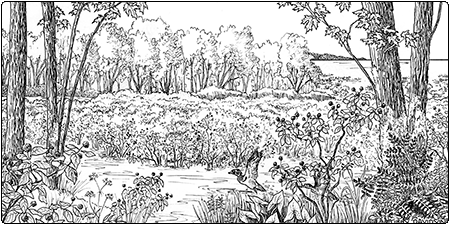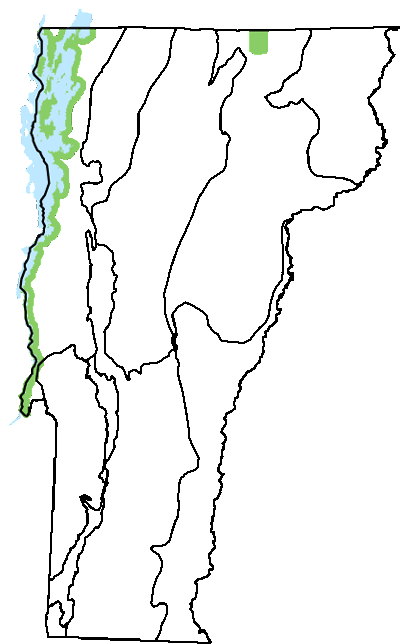Ecology and Physical Setting 
Lakeside Buttonbush Swamps are Vermont’s wettest shrub swamps. They occur adjacent to larger lakes and ponds or are associated with lake-influenced oxbow ponds and backwater depressions in the floodplains of and near the mouths of our larger rivers. They are often found with Deep Bulrush Marshes, Wild Rice Marshes, or Lakeside Floodplain Forests. In most years, the lake levels rise substantially each spring from rain and snowmelt—flooding these swamps—and then recede over the course of the summer. Even during periods of low water, the substrate usually remains saturated, resulting in deep organic muck soils. Most of our Lakeside Buttonbush Swamps occur along the edges of Lake Champlain in protected bays and coves. Here, they form distinctive circular clones in a mosaic of deepwater marshes that are clearly visible from above.
Vegetation 
Because of its remarkable tolerance for flooding, buttonbush is often the only woody plant occurring in these swamps. Its low, spreading, and sprawling habit, with exposed roots above the soil, opposite or whorled leaves, and dense round heads of flowers and fruits give these swamps a very distinctive appearance. Willow species, meadowsweet, or other shrubs may also be present, but rarely in any abundance. When found adjacent to floodplain forests, saplings of silver maple and green ash can be common, but seldom survive to tree size.
Herbaceous plant diversity is variable from swamp to swamp. In the wettest swamps, herbs are sparse, if they are present at all. An occasional marsh fern may grow from the fibrous base of buttonbush shrubs, or there may be a few plants of small water plantain or floating pondweed. Common duckweed is abundant where there is standing water. In swamps with shallower water, species diversity may be higher. In these situations, one can find water willow, giant bur-reed, wild rice, marsh mermaid-weed, three-way sedge, and broad-leaved arrowhead. In dry years when the muddy swamp substrates become exposed, several species of annual beggar’s-ticks may become established. The moss Drepanocladus aduncus is commonly found attached to the exposed roots and stems of buttonbush near water level and is apparently well adapted to seasonal inundation.
Wildlife Habitat
These very wet lakeside swamps provide breeding habitat and protective cover for several frog species, including green frog, spring peeper, gray treefrog, American bullfrog, and northern leopard frog. The abundant frogs provide food for hunting minks, green herons, great blue herons, and black-crowned night herons. Lakeside Buttonbush Swamps provide breeding habitat for wood ducks, mallards, and American black ducks. Other birds that use these swamps include Virginia rail, least bittern, American bittern, common yellowthroat, red-winged blackbird, pied-billed grebe, and common gallinule. Buttonbush seeds can be an important source of food for waterfowl and shorebirds, and buttonbush flowers provide nectar for many species of bees. Black terns are a very rare breeding bird in Vermont and their numbers have declined significantly in recent decades. This decline is attributed to degradation of their nesting sites, a result of increased boating activity and the spread of common reed and purple loosestrife. These graceful fliers nest in colonies on plant debris that accumulates at the bases of buttonbush and on other floating vegetation mats.
Related Communities
- Basin Shrub Swamps can have buttonbush as a dominant species, but these small swamps are restricted to isolated basins that are not associated with lakes.
Conservation Status and Management Considerations
This is a rare natural community in Vermont. Several high-quality examples are protected on conserved lands. Lakeside Buttonbush Swamps are maintained by specific hydrologic conditions of their associated lakes and backwaters. Hydrologic alterations that lead to shorter or longer periods of flooding or changes in the depth of flooding are likely to result in a change in species composition.
Distribution/Abundance 
Lakeside Buttonbush Swamps are found adjacent to or hydrologically connected to large lakes and ponds or slow-moving rivers that have seasonal water fluctuations. The largest examples are associated with Lake Champlain. They occur throughout eastern North America.
Characteristic Plants
Shrubs
Abundant Species
Buttonbush – Cephalanthus occidentalis
Occasional Species
Meadowsweet – Spiraea alba
Silver maple – Acer saccharinum
Green ash – Fraxinus pennsylvanica
Willows – Salix spp.
Herbs
Occasional to Locally Abundant Species
Marsh fern – Thelypteris palustris
Small water plantain – Alisma subcordatum
Floating pondweed – Potamogeton natans
Common duckweed – Lemna minor
Water willow – Decodon verticillatus
Giant bur-reed – Sparganium eurycarpum
Southern wild rice – Zizania aquatica
Northern wild rice – Zizania palustris
Three-way sedge – Dulichium arundinaceum
Broad-leaved arrowhead – Sagittaria latifolia
Rice cutgrass – Leersia oryzoides
Water parsnip – Sium suave
Bulb-bearing water hemlock – Cicuta bulbifera
Royal fern – Osmunda regalis
Nodding beggar’s-ticks – Bidens cernua
Common beggar’s-ticks – Bidens frondosa
Bryophytes
Occasional to Locally Abundant Species
Moss – Drepanocladus aduncus
Moss – Leptodictyum riparium
Rare and Uncommon Plants
Marsh mermaid-weed – Proserpinaca palustris
Yellow water-crowfoot – Ranunculus flabellaris
Associated Animals
Gray treefrog – Hyla versicolor
Spring peeper – Pseudacris crucifer
Northern leopard frog – Lithobates pipiens
Green frog – Lithobates clamitans
American bullfrog – Lithobates catesbeianus
Mink – Neovison vison
Wood duck – Aix sponsa
Mallard – Anas platyrhynchos
Virginia rail – Rallus limicola
Common yellowthroat – Geothlypis trichas
Red-winged blackbird – Agelaius phoeniceus
Rare and Uncommon Animals
Eastern ribbonsnake – Thamnophis sauritus
Black-crowned night-heron – Nycticorax nycticorax
Pied-billed grebe – Podilymbus podiceps
Common gallinule – Gallinula galeata
Least bittern – Ixobrychus exilis
American bittern – Botaurus lentiginosus
Black tern – Chlidonias niger
American black duck – Anas rubripes
Places to Visit
Lower Black River, South Bay Wildlife Management Area, Vermont Fish and Wildlife Department
Missisquoi National Wildlife Refuge, Swanton and Highgate, U.S. Fish and Wildlife Service
Derway Island, Burlington, Winooski Valley Park District
LaPlatte River Marsh Natural Area, Shelburne, The Nature Conservancy
Rossetti Beach Natural Area, Colchester, Lake Champlain Land Trust
